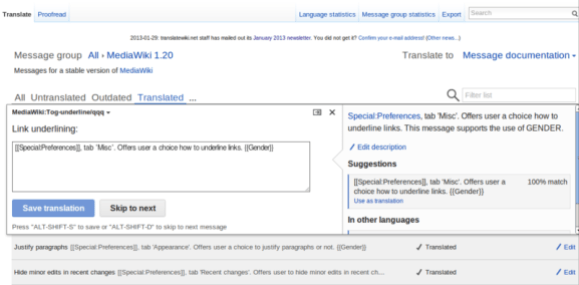Lel the tacho pirrow, an’ it’s pars kaired — A Romani proverb
The Wikimedia Language Engineering team just completed its most recent development sprint, to introduce a new iteration of the Translation Editor within the Translate Extension, and include features to make it more satisfactory as a translation workspace. The primary focus during this sprint has been to make the editor ready for production use. Some members of the team also attended FOSDEM 2013 in Brussels.
Translate interface features & enhancements
Paste Source Text — Often found in translation editors, this feature allows for the source text to be easily copied over into the translation edit box. It’s now available in Translate and is particularly helpful when large portions of the source messages can be reused in the translation.
Message Documentation Display — Details about the messages within a project for translation can now be seen for all messages in a page, by picking the special “Message Documentation” language in the “Translate to” selector. This advanced option allows translators to view and evaluate the context for the messages that they are translating and also to see all the messages that were not documented yet.

Translation Editor UI — The other enhancements that help translators to quickly review messages include:
- Unchanged translations marked as “outdated” can be marked as suitable for use using the Confirm Translation button.
- When translating a message, the translation aids of the subsequent message gets preloaded to avoid any delay during navigation.
- Groups of messages, especially within Translation Pages with longer content, can now be set to a different state through a button click on a redesigned interface. This feature helps in identifying the Pages that can be pushed for publication.
- Machine Translation suggestions from Apertium, Microsoft, and Yandex can now be dynamically presented for each message on the editor.
Besides the above, Search and Translation Editor were cross-integrated for translators, to edit Translations directly from the page displaying search results.

Pau Giner conducted a walkthrough of Translate user experience improvements, demonstrating the current state of development and the upcoming features for this extension.
Translate API changes — Changes to the Translate API now provide more information for the developers via the Web API, to help them implement customized translation interfaces.
During the development cycle, the team also engaged with the larger community to gather feedback about the new features through usability tests.
In other good news, jQuery.ime was successfully implemented on the Koha Library management system (v. 3.10) by Indranil Dasgupta. Also, do see this wonderful video about jQuery.ime by Chris Forno that blew us away.
Focus for the next sprint
Further enhancements to Translate continue to be the main focus for the next sprint. This includes review and testing of the latest designs. The Language Engineering team hopes to have more interaction in this regard at the Open Source Language Summit (organised and hosted in collaboration with Red Hat) and at GNUnify in Pune, India.
Runa Bhattacharjee, Outreach and QA coordinator, Language engineering

Can you help us translate this article?
In order for this article to reach as many people as possible we would like your help. Can you translate this article to get the message out?
Start translation